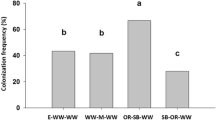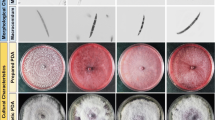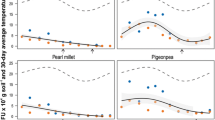Abstract
Data from a national survey were analysed to investigate whether there was interdependence among the Fusarium species, which cause the stem rot complex of wheat. About 25 wheat stems were sampled from each of 260 sites over the main wheat growing areas in the UK. Occurrence of each Fusarium species on individual stems was determined. Fusarium culmorum, F. avenaceum and Microdochium nivale were the three dominant species, detected in 248, 185 and 239 out of the 260 sites. There were no interactions among species in the distribution of the three species over the 260 sites. Several statistical tests were used to determine whether there was interdependence among the three species on the same stem within each site. Of the three species, there was only limited evidence of competition between F. culmorum and F. avenaceum.
Similar content being viewed by others
References
Booth C (1971) The Genus Fusarium, Commonwealth Mycological Institute, Kew, Surrey, UK, p 237
Colhoun J and Park D (1964) Fusarium diseases of cereals I. Infection of wheat plants, with particular reference to the effects of soil moisture and temperature on seedling infection. Transactions of the British Mycological Society 47: 559-572
Colhoun J, Taylor GS and Tomlinson R (1968) Fusarium diseases of cereals II. Infection of seedlings by F. culmorum and F. avenaceum in relation to environmental factors. Transactions of the British Mycological Society 51: 397-404
Cook RJ (1970) Factors affecting saprophytic colonization of wheat straw by Fusarium roseum f. sp. cerealis 'Culmorum'. Phytopathology 60: 1672-1676
Cox DR and Snell EJ (1989) Analysis of Binary Data, Chapman and Hall, London
Duben J and Fehrmann H (1979) Vorkommen und pathogenität von Fusarium-Arten an Winterweizen in der Bundesrepublik Deutschland. I. Artenspektrum und jahreszeitliche Sukzession an der Halmbasis. Zeitschrift für Pflanzenkrankheiten und Pflanzenschutz 86: 638-652
Locke T, Moon LM and Evans J (1987) Survey of benomyl resistance in Fusarium species on winter wheat in England and Wales in 1986. Plant Pathology 36: 589-593
Nicholson P, Lees AK, Maurin N, Parry DW and Rezanoor HN (1996) Development of a PCR assay to identify and quantify Microdochium nivale var. nivale and Microdochium nivale var. majus in wheat. Physiological and Molecular Plant Pathology 48: 257-271
Nicholson P, Simpson DR, Weston G, Rezanoor HN, Lees AK, Parry DW and Joyce D (1998) Detection and quantification of Fusarium culmorum and Fusarium graminearum in cereals using PCR assays. Physiological and Molecular Plant Pathology 53: 17-37
Parry, DW (1990) The incidence of Fusarium spp. in stem bases of selected crops of winter wheat in the Midlands, UK. Plant Pathology 39: 619-622
Parry DW, Pettitt TR, Jenkinson P and Lees AK (1994) The cereal Fusarium complex. In: Blakeman JP and Williamson B (eds) Ecology of Plant Pathogens (pp 301-320) CAB International, Wallingford, UK
Payne RW, Lane PW, Todd AD, Digby PGN, Thompson R, Harding SA, Wilson TG, Leech PK, Welham SJ, Morgan GW and White RP (1993) Genstat™ 5 Release 3: Reference Manual, Oxford University Press, Oxford
Pettitt TR and Parry DW (2001) Effect of temperature on Fusarium foot rot of wheat. In: Summerell BA, Leslie JF, Backhouse D and Bryden WL (eds) Fusarium: Paul E Nelson Memorial Symposium (pp 145-160) American Phytopathological Society Press, St Paul MN, USA
Pettitt TR, Parry DW and Polley RW (1993) Improved estimation of the incidence of Microdochium nivale in winter wheat stems in England and Wales, during 1992, by use of benomyl agar. Mycological Research 97: 1172-1174
Pettitt TR, Parry DW and Polley RW (1996) Effects of temperature on the incidence of nodal foot rot symptoms in winter wheat crops in England andWales caused by Fusarium culmorum and Microdochium nivale. Agricultural and Forest Meteorology 79: 233-242
Polley RW and Thomas MR (1991) Surveys of diseases of winter wheat in England and Wales, 1976-1988. Annals of Applied Biology 119: 1-20
Schilling AG, Moller EM and Geiger HH (1996) Polymerase chain reaction-based assays for species-specific detection of Fusarium culmorum, F. graminearum and F. avenaceum. Phytopathology 86: 515-522
Smiley RW and Patterson L-M (1996) Pathogenic fungi associated with Fusarium foot rot of winter wheat in the semiarid Pacific Northwest. Plant Disease 80: 944-949
Turner AS, Lees AK, Rezanoor HN and Nicholson P (1998) Refinement of PCR-based detection of Fusarium avenaceum and evidence for phenetic relatedness to Fusarium tricinctum. Plant Pathology 47: 278-288
Zadoks JC, Chang TT and Konzak CF (1974) A decimal code for the growth stages of cereals. Weed Research 14: 415-421
Author information
Authors and Affiliations
Corresponding author
Rights and permissions
About this article
Cite this article
Pettitt, T., Xu, X. & Parry, D. Association of Fusarium Species in the Wheat Stem Rot Complex. European Journal of Plant Pathology 109, 769–774 (2003). https://doi.org/10.1023/A:1026042711064
Issue Date:
DOI: https://doi.org/10.1023/A:1026042711064




